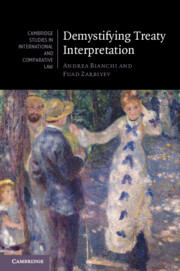Book contents
- Demystifying Treaty Interpretation
- Cambridge Studies in International and Comparative Law: 188
- Demystifying Treaty Interpretation
- Copyright page
- Contents
- Figures
- Preface
- Abbreviations
- 1 The Province of the Rules of Treaty Interpretation
- 2 The Interpreter’s Self
- 3 The Genealogy of the Contemporary Regime of Treaty Interpretation
- 4 Textualism
- 5 Intentionalism
- 6 What’s the Purpose of ‘Object and Purpose’?
- 7 Supplementary Means
- 8 The Magic of Systemic Integration
- 9 Inferential Reasoning and Its Consequences
- 10 Time and Treaty Interpretation
- 11 Text, Author, and Interpretive Control
- 12 Power, Persuasion, and Authority
- Annex Vienna Convention on the Law of Treaties 1969
- Index
- Cambridge Studies in International and Comparative Law
3 - The Genealogy of the Contemporary Regime of Treaty Interpretation
Published online by Cambridge University Press: 07 March 2024
- Demystifying Treaty Interpretation
- Cambridge Studies in International and Comparative Law: 188
- Demystifying Treaty Interpretation
- Copyright page
- Contents
- Figures
- Preface
- Abbreviations
- 1 The Province of the Rules of Treaty Interpretation
- 2 The Interpreter’s Self
- 3 The Genealogy of the Contemporary Regime of Treaty Interpretation
- 4 Textualism
- 5 Intentionalism
- 6 What’s the Purpose of ‘Object and Purpose’?
- 7 Supplementary Means
- 8 The Magic of Systemic Integration
- 9 Inferential Reasoning and Its Consequences
- 10 Time and Treaty Interpretation
- 11 Text, Author, and Interpretive Control
- 12 Power, Persuasion, and Authority
- Annex Vienna Convention on the Law of Treaties 1969
- Index
- Cambridge Studies in International and Comparative Law
Summary
This chapter frames the interpretive regime of modern international law as a historical contingency and aims to trace its genealogy through an analysis of the codification process that led to the current regime. The contingency of the rules of treaty interpretation is hardly recognized in the official discourse. Treated as a matter of common sense or trans-historical customary international law, the rules of treaty interpretation set forth in the Vienna Convention on the Law of Treaties have for instance been applied to the interpretation of treaties dating back to the nineteenth century and a whole range of treaties concluded in the twentieth century before the entry into force of the Vienna Convention. There is, however, ample evidence that the interpretive approach of the Vienna Convention has by no means prevailed throughout the history of international law. This chapter identifies a series of factors ranging from the intellectual history of the discipline of international law and the contingencies of the codification process, to the political circumstances of the Cold War era and the rise of permanent international tribunals that can account for the normative outcome of the Vienna Convention regime.
Keywords
- Type
- Chapter
- Information
- Demystifying Treaty Interpretation , pp. 49 - 84Publisher: Cambridge University PressPrint publication year: 2024

